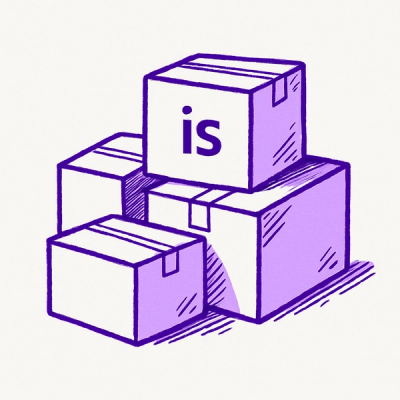
Security News
npm ‘is’ Package Hijacked in Expanding Supply Chain Attack
The ongoing npm phishing campaign escalates as attackers hijack the popular 'is' package, embedding malware in multiple versions.
sqlite-replication
Advanced tools
A Typescript module to replicate SQLite DB with server.
sqlite-replication was designed for collaborative offline-first mobile app built with capacitor sqlite plugin.
npm install sqlite-replication --save
// init your SQLite db as usual
const db = ...
const storage = new ReplicationSQLiteStorage(db);
const replicationService = new ReplicationService(storage,
{
// Provide collections descriptor to replicate
collections: [
// use a default helper
ReplicationHelpers.getDefaultCollectionOptions(db, 'users'),
// or define your own config
{
name: 'todos',
batchSize: 99,
getDocumentOffset: async (updatedAt: number,id: string) => { ... },
upsertAll: (documents: any[]) => { ... },
deleteAll: (documents: any[]) => { ... },
findChanges: (state: ReplicationConfig) => { ... };
}
],
// Define how to pull data from your own server (Rest, GraphQL... up to you)
fetchPull: async (pullConfig: any) => (await api.post(`${URL_BASE}/replicationPull`, pullConfig)).data,
// Define how to push data to your server
fetchPush: async () => (await api.post(`${URL_BASE}/replicationPush`, {})).data,
}
);
// init checkpoint table at app startup time
await replicationService.init();
// run replication (push then pull) when required, as often as you need
await replicationService.replicate();
//Enjoy SQL query as usual
Ensure your tables have at least these columns :
id as text, as primary key (UUID recommended)updateAt as timestamp, the last document change datedeletedAt as timestamp, the deletion date (if deleted)_forkParent as text, used for conflict handling.deletedAt timestamp insteadidupdateAtdeletedAt_forkParent is not required in server storage and could be removeddeletedAt timestamp insteadORDER BY "updatedAt", "id"id is filled in a compatible way with distributed context (prefer UUID or similar)const mobilePullBodySchema = {
body: {
type: 'object',
properties: {
// Map of collections to pull
collections: {
type: 'object',
properties: {},
// additional properties names should match SQLite table name
additionalProperties: {
type: 'object',
properties: {
// The cursor (the last already pulled document updatedAt property, as integer)
cursor: { type: 'number' },
// The number of documents to pull
limit: { type: 'number', format: 'int64' },
/*
* offset N documents.
* `updatedAt` should be the last date the document changes. Its use as cursor.
* But in case of multiple updates in a single query, several documents could have the same updatedAt value.
* This use-case breaks the cursor use and the paginating feature.
* As workaround, we use this parameter to know how much documents with the cursor value has already been pulled and paginate correctly.
*/
offset: { type: 'number', format: 'int64' },
},
required: ['cursor', 'limit', 'offset'],
},
},
},
required: ['collections'],
},
};
app.post('/replicationPull', validate(mobilePullBodySchema), async (req, res) => {
const collections = {};
// Query users only if required
if ( req.body.collections.users ) {
const { cursor, offset, limit } = req.body.collections.users;
const users = await database.select(
'id',
'name',
database.knex.raw('EXTRACT(EPOCH FROM "updatedAt") as "updatedAt"'),
'deletedAt',
)
.from('users')
// pay attention to predictability for paginating
.orderBy(['updatedAt', 'id'])
// get only changed users since the last updateAt value (>=)
.where(database.knex.raw(`date_trunc('milliseconds',"updatedAt")`), '>=', database.knex.raw(`to_timestamp(${cursor})`)`))
// get the page data +1 to know if there is one more page next in a single sql query
.limit(limit + 1)
// skip the N first document with asked updateAt
.offset(offset);
}
collections.users = {
// escape the last document if the page limit is reach (due to limit+1)
documents: users.length > limit ? users.slice(0, -1) : users,
// define if there is a next page
hasMoreChanges: users.length > limit,
cursor,
offset,
limit,
});
}
res.json({ collections });
});
router.post('/replicationPush', validate(replicationPushSchema), async (req, res) => {
const collections = req.body.collections;
if (collections.users) {
await Promise.all(collections.users.map(pushUser));
}
res.json('ok');
});
async function pushUser(user) {
const forkParent = user._forkParent;
delete user._forkParent;
// remotely created case (insert), note that `id` is filled by client
if (forkParent.updatedAt === null) {
// insert in DB, note that `updateAt` default value is now()
return usersService.create(user)
}
// remotely deleted case (delete)
else if (user.deletedAt) {
// no deletion just flag the document with `deletedAt`=now() and `updateAt`=now() too.
return usersService.update({...user,updateAt:Date.now()});
}
//remotely update case
else if (forkParent.updatedAt !== user.updatedAt) {
const serverDocument = await usersService.getById(user.id),
// deleted on server (ignore remote update)
if (!serverDocument || serverDocument.deletedAt) {
return;
}
// no conflict case
else if (serverDocument.updatedAt === forkParent.updatedAt) {
return usersService.update({...user,updateAt:Date.now()});
}
//Conflict case
else {
const remoteChangedKeys = Object.keys(user).filter(
(key) => JSON.stringify(user[key]) !== JSON.stringify(forkParent[key]),
);
const serverChangedKeys = Object.keys(user).filter(
(key) => JSON.stringify(serverDocument[key]) !== JSON.stringify(forkParent[key]),
);
// handle conflict according to business rules
...
}
}
}
A replication starts by sending local changes to the server then getting changes from the server. By the way, server could fix conflicts and include merged documents during the pull step.
updatedAt >= last updateAt pulled (+ offset), this including deleted documents._forkParent property with a stringify version of the last server version known, to allow to the server to know changes at the property level._forkParent property document = {...document, _forkParent: JSON.stringify(document)}hasMoreDocument are false.replicationService.replicationCompleted observable trigger a new value.ReplicationOptions interface defines two required hooks : fetchPush&fetchPull to define your way to reach the serverReplicationHelpers.getDefaultCollectionOptions(tableName) generaly works by feel free to provide your own ReplicationCollectionOptions to customize access to SQLite tablesexport interface ReplicationCollectionOptions {
name: string;
batchSize: number;
// This hook is called to update data to SQLite
upsertAll: (documents: any[]) => Promise<void> | Promise<capSQLiteChanges>;
// This hook is called to remove data to SQLite
deleteAll: (documents: any[]) => Promise<void> | Promise<capSQLiteChanges>;
// This hook is called to define the document offset from `updatedAt` and `id`
getDocumentOffset: (updatedAt: number, id: string) => Promise<number>;
findChanges: (config: ReplicationConfig) => Promise<number>;
}
capacitor-community/sqlite UpgradeDatabaseVersion works well and is provided by SQLite itself.
FAQs
A Typescript module to replicate SQLite DB with server.
The npm package sqlite-replication receives a total of 2 weekly downloads. As such, sqlite-replication popularity was classified as not popular.
We found that sqlite-replication demonstrated a not healthy version release cadence and project activity because the last version was released a year ago. It has 1 open source maintainer collaborating on the project.
Did you know?

Socket for GitHub automatically highlights issues in each pull request and monitors the health of all your open source dependencies. Discover the contents of your packages and block harmful activity before you install or update your dependencies.

Security News
The ongoing npm phishing campaign escalates as attackers hijack the popular 'is' package, embedding malware in multiple versions.

Security News
A critical flaw in the popular npm form-data package could allow HTTP parameter pollution, affecting millions of projects until patched versions are adopted.

Security News
Bun 1.2.19 introduces isolated installs for smoother monorepo workflows, along with performance boosts, new tooling, and key compatibility fixes.